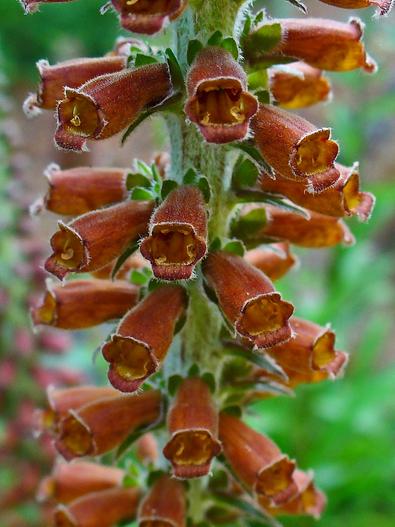Chocolate Foxglove
(Digitalis parviflora)
Chocolate Foxglove (Digitalis parviflora)
/
/

H. Zell
CC BY-SA 3.0
Image By:
H. Zell
Recorded By:
Copyright:
CC BY-SA 3.0
Copyright Notice:
Photo by: H. Zell | License Type: CC BY-SA 3.0 | License URL: https://creativecommons.org/licenses/by-sa/3.0 | Uploader: Llez | Publisher: Wikipedia Commons









































Estimated Native Range
Summary
Digitalis parviflora, commonly known as chocolate foxglove or small-flowered foxglove, is a short-lived perennial or biennial herb native to the Iberian Peninsula, specifically northern and central Spain, where it thrives in open woodlands and on mountain slopes at elevations of 1640-6562 feet (500-2000 meters). It typically grows to a height of 18-24 inches (45-60 cm) and is known for its slender spires of tubular, rust-red to chocolate-brown flowers that bloom from late spring to early summer. The foliage forms a downy rosette at the base, and the plant’s overall appearance is elegant and distinctive.
Chocolate foxglove is valued for its unique flower color and vertical accent in garden designs. It is often used in border plantings, woodland gardens, and cottage gardens. It has a preference for semi-shaded positions and requires damp, well-drained soil with rich organic matter. While it is relatively easy to maintain, it does not tolerate dry conditions well. The cultivar ’Milk Chocolate’ is particularly noted for its subtle flower color and has been awarded the Royal Horticultural Society’s Award of Garden Merit for its garden performance. Chocolate foxglove is also attractive to bees and other pollinators, adding to its horticultural value. However, all parts of the plant are toxic if ingested, and it should be handled with care, especially around children and pets.CC BY-SA 4.0
Chocolate foxglove is valued for its unique flower color and vertical accent in garden designs. It is often used in border plantings, woodland gardens, and cottage gardens. It has a preference for semi-shaded positions and requires damp, well-drained soil with rich organic matter. While it is relatively easy to maintain, it does not tolerate dry conditions well. The cultivar ’Milk Chocolate’ is particularly noted for its subtle flower color and has been awarded the Royal Horticultural Society’s Award of Garden Merit for its garden performance. Chocolate foxglove is also attractive to bees and other pollinators, adding to its horticultural value. However, all parts of the plant are toxic if ingested, and it should be handled with care, especially around children and pets.CC BY-SA 4.0
Plant Description
- Plant Type: Herb
- Height: 3-5 feet
- Width: 1-2 feet
- Growth Rate: Moderate
- Flower Color: Brown, White
- Flowering Season: Spring, Summer
- Leaf Retention: Deciduous, Semi-deciduous
Growth Requirements
- Sun: Full Sun, Part Shade
- Water: Low, Medium
- Drainage: Medium
Common Uses
Border Plant, Low Maintenance, Potted Plant
Natural Habitat
Native to open woodlands and mountain slopes in northern and central Spain
Other Names
Common Names: Small-flowered Foxglove , Spanish Foxglove , Chocolate Soldier , Kleinblütiger Fingerhut
Scientific Names: Digitalis parviflora , Digitalis ferruginea
GBIF Accepted Name: